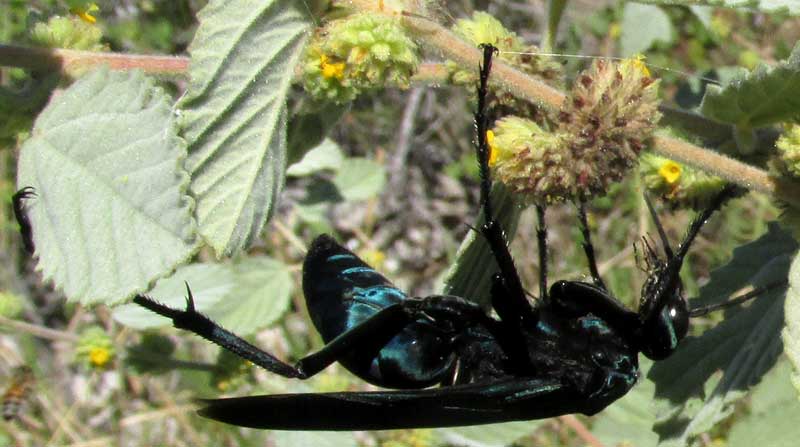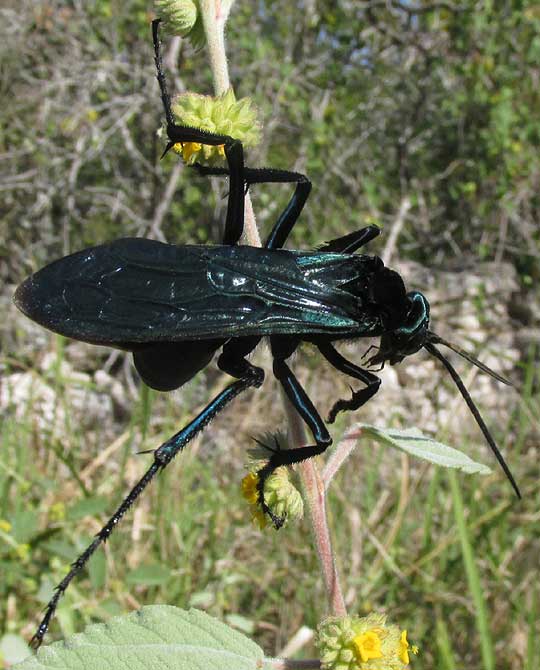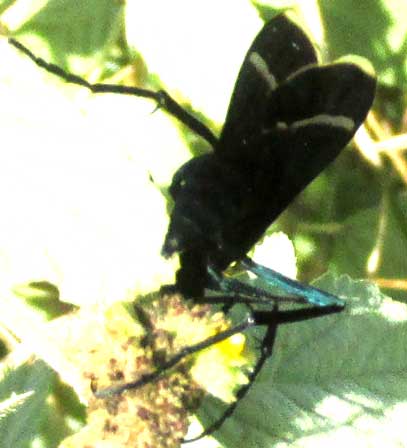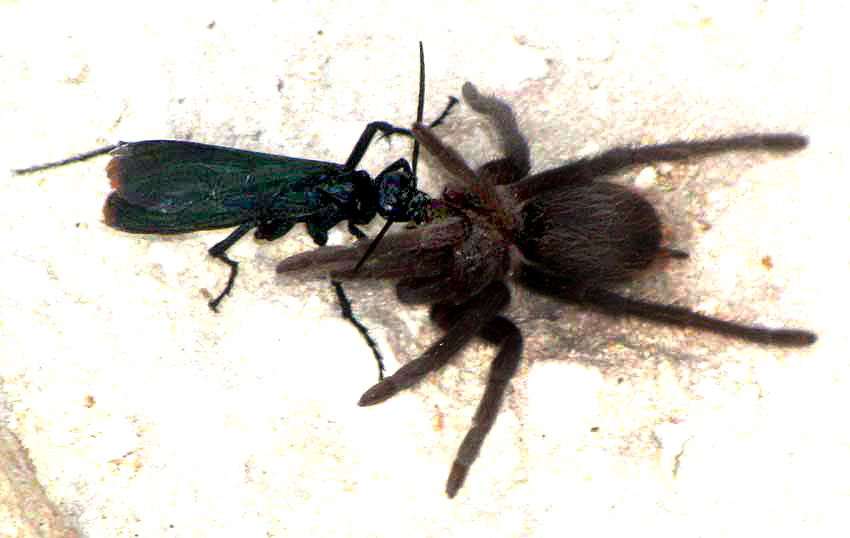Excerpts from Jim Conrad's
Naturalist Newsletter

from the December 21, 2014 Newsletter issued from Río Lagartos, on the Yucatan Peninsula's northern coast (~N21.60°, ~W88.16°), Yucatán state, MÉXICO
MEXICAN TARANTULA HAWK
When you're out birding with your mind alert for movements of things of a certain size, down here there's this big insect that again and again makes you think you're seeing a hummingbird. It flies with its long back legs dangling behind, at first looking like a Mexican Sheartail with its long tail. It happens all the time and all these false alerts are frustrating. For years I've been trying to photograph the insect so I could figure out who it is, but it's fast moving and I've seldom seen it land.
But this week in a large roadside population of flowering Waltheria americana several of these hummingbird-mimickers were busy feeding on flower pollen and finally I got some pictures. One is shown above.
Obviously it's a wasp, and a big one, nearly 2 inches long (5cm). Basically it's black, with blue iridescence coming and going as the wasp moves about. Another shot from above the wasp, showing the wing venation for good identification, is shown below:

Another shot, a bit blurry but displaying an important feature, appears below:

That shows the folded-back wings' lower surface, and it appears that each wing has a white band at its tip, and another a little below it. However, remember that wasps have four wings. I'm interpreting what appears to the be the second white band on each wing as tips of the lower pair of wings. The description of the species I think this is says that all four wings are completely black except for their white wingtips.
I'm calling this the Mexican Tarantula Hawk, PEPSIS MEXICANA, occurring in arid areas from the southwestern US near Mexico south into Costa Rica. I think we've met this wasp before, on the Caribbean coast north of Mahahual, pulling along a tarantula it had just paralyzed with a sting. {next entry below}
The tarantula hawk wasp in those photos isn't planning to eat the tarantula itself. Adult tarantula hawk wasps, like our roadside ones among the Waltherias, feed on pollen and nectar. However, their larvae do eat tarantulas. Here's the story:
When an adult female tarantula hawk wasp is ready to lay an egg, it locates a tarantula by smell, possibly having to enter the tarantula's burrow to drag it out, and then the wasp may need to wrestle with the tarantula it until it can deliver a sting. The sting paralyzes the tarantula almost immediately, and the tarantula stays paralyzed for the rest of its sad life. The paralyzed tarantula is dragged into a burrow the wasp has dug into the ground, the wasp lays her egg with the tarantula, and the chamber is sealed. When the egg hatches, the tiny larva immediately begins feeding on it. The tarantula remains alive, but paralyzed, until the final stages of the larva's growth.
Tarantula hawk wasps also sting humans and their stings are regarded as among the most painful of all insect stings. However, they're not dangerous unless you have a special sensitivity. Happily, the wasps aren't aggressive toward humans, and sting only when aggressively provoked.
Tarantula hawks can be hard to identify, and there's a second genus, Hemipepsis, that looks very much like our Pepsis. However, the strong iridescence and pale wingtips of an otherwise all-black wasp point to this species. Also, distribution maps disqualify other Pepsis species treated in CR Vardy's 2000 work, "The New World tarantula-hawk wasp genus Pepsis Fabricius (Hymenoptera: Pompilidae)," which can be downloaded for free at http://www.repository.naturalis.nl/document/46285.
from the September 25, 2011 Newsletter issued from Mayan Beach Garden Inn 20 kms north of Mahahual; Caribbean coastal beach and mangroves, ~N18.89°, ~W87.64°, Quintana Roo state, MÉXICO
TARANTULA HAWK WASP

On the white sand road late the other afternoon when everything already was in shadow, I came upon a very large wasp pulling a tarantula across the road, shown above. We've all seen wasps carrying spiders to their nests but this was my first tarantula. Suddenly the wasp left the tarantula in the middle of the road, and while it wandered around checking things where I got the nice close-up of the tarantula's "face" below:

As soon as I withdrew from the tarantula, the wasp returned and continued pulling her prey across the road.
A tarantula expert I correspond with tells me that probably the tarantula in our picture is an immature BRACHYPELMA VAGANS, or at least something currently called B. vagans because no-one knows what else to call it. If that's so, this one is different from the poorly known and relatively small tarantula species we've seen up at Chichén Itzá, the Yucatan Redrump, Brachypelma epicureanum.
It took volunteer identifier Bea in Ontario to direct me to a group of wasps known as tarantula hawks, who do drag tarantulas around. The group incorporates two genera, Pepsis and Hemipepsis. Because of our wasp's large size I'm guessing it's a Pepsis.